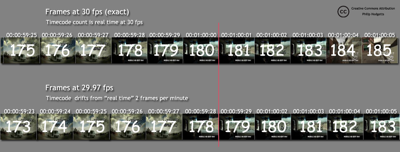Although I come from a country where we count frame rates in whole numbers and, therefore don’t need to skip frame counts in the timecode, I thought I understood it at least as well, or better, than “NTSC natives”. That is, until I really, truly had to understand it to ensure the reported time counts in Sequence Clip Reporter are accurate.
Well, it took three pieces of additional information before I truly understood it: Rainer Standke’s insistence that “frame is a frame is a frame”; the realization (although known) that 29.97 is actually slower than 30 fps with the consequence that each frame runs slightly longer than at 30 fps; and that the correction can’t be applied evenly.
At one level I knew all of these things, but it really all came together when I got the “right” mental picture. Since I could not find any illustrations that showed why the skip-frame timecode (a better term than drop frame imnsho) needed to skip frames, I decided to create this one. It’s licensed with a Creative Commons – Attribution license. That means you can reproduce it, or use it for any purpose as long at the attribution to me remains.
Not shown on the image is that the 2 frame skip-forward happens at every minute, except ever 10 minutes. There are other parts to the pattern as the timescale gets longer.

9 replies on “What is drop-frame Timecode?”
Is it me or is the illustration kind of cut off?
Could be, that’s the first time I’ve tried to put in an image that big.
Philip
There, fixed now. I put in a smaller image that fits the theme and linked to the full size version.
Philip
Ah. Cool. Now I get it.
🙂
With the multitude of frame rates available with current generation cameras why is drop frame timecode used anymore?
Where material is being made for web purposes there is no need to stick with archaic NTSC framerate with odd fractions per second. Shoot at 24, 25, 30 or even 60 frames a second and all your cuts will be exactly the length you think they are!
Well, you can never, ever work in interger frame rates and display on a video monitor, so shooting those frame rates is not recommended or desirable. That’s not particularly important unless you deliver a 60 second TVC, or any show for broadcast. Broadcast (or other places where real, exact run time is important) will reject something that is the wrong run time.
Philip
Phillip, your diagram doesn’t explain WHY there is a need for Drop Frame Time Code. Here’s my explanation:
The difference in the total number of frames between 29.97fps NTSC video and exact 30fps video is approximately 108 frames per hour. IOW, there are 108 FEWER frames of video at 29.97fps than there are in 30fps video. In order to make 29.97fps NTSC video time code run at accurate clock time (where an hour of video displays exactly one hour of DF TC), those 108 frame numbers must be skipped so that the clock time (as represented by time code) will ‘catch up’ to actual clock time and be accurate at the end of the hour.
It was decided (I think SMPTE made this the standard) to skip 2 frames every minute except on the tens-of-minutes. There are of course 60 minutes per hour. If you skipped 2 frames for each minute, that would be 120 skipped numbers, which is too many skipped frame numbers. By NOT skipping frame numbers on the tens-of-minutes, there would be 6 occasions when numbers would NOT be skipped each hour. Since each skipping occurrence skips 2 frames, that means 12 frames would NOT be skipped on those special instances. The result is 120 minus 12, which is of course 108; the exact number of frames that must be skipped each hour.
I’ve known the “why” and the rest of the description for more than 15 years and it wasn’t that helpful. That’s why I had to draw it for myself (mentally first then a real image). The explanation is readily available (Wikipedia et al) and was completely unhelpful in visualizing what’s going on. Perhaps the explanation and the visual together will make it clearer to others.
I know the why and how, but really, non-integer frames rates should have been killed.
There is no reason to have kept them. The “issues” stated could have been dealt with by the new tech.
I feel it was more of the vendors weaving black bullshit trying to fool the purchasers. “We support more standards” – (Most you should never use…)
Non- integer frames rates is a crime. In the end it just costing us all more time and money.
James